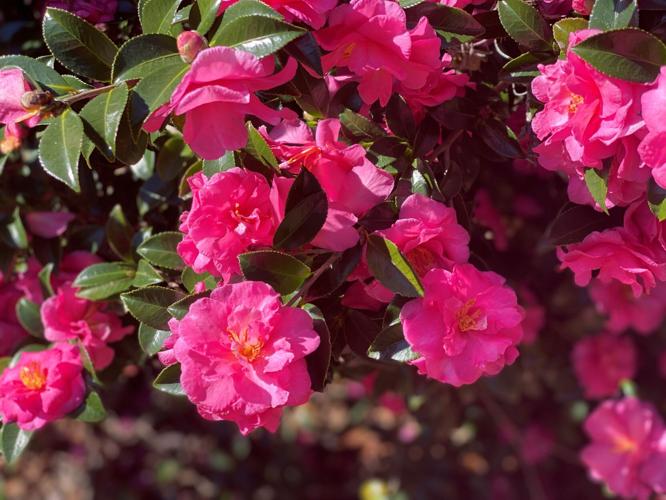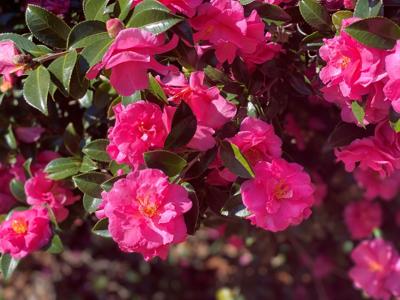Camellias are almost indispensable in the Southern landscape. Now is an excellent time to purchase and plant blooming camellias. The advantage of buying a camellia in bloom is that you can see exactly the size, shape and color of the flowers it will produce.
Plant camellia bushes into a well-prepared spot where the soil has been generously amended with organic matter, such as compost or peat moss. Gardeners south of Lake Pontchartrain should also consider adding copperas or sulfur during bed preparation to acidify the soil.
The planting location should be a well-drained spot that receives part sun to part shade. These long-lived shrubs will brighten up your winter and early spring landscape for decades.

Camellias flower only when exposed to the short-day lengths that naturally occur in winter. They're called a short-day plant.
Camellias in containers
Many gardeners have never considered using camellias as a container plant. As beautiful as they are in the ground, camellias adapt happily to life in containers and are particularly impressive grown that way. They look great flanking entryways, on decks, patios and porches and other outdoor living areas. Another species of camellia, the fall blooming sasanquas (Camellia sasanqua), also looks great in containers.
And there's another advantage. How many of you have containers of lush tropical plants that have to be dragged into the garage for the freezes and then moved back out again through the winter months? Because camellias are quite cold hardy, they do not have to be coddled during freezes. You may leave them outside over the winter season.
Choosing a container
The type of pot you choose is as much a matter of taste as what is best for the camellias. Black plastic pots from the nursery work fine but look a bit too utilitarian for most landscapes. Decorative plastic in muted colors, terra cotta, fiberglass and glazed pottery all make suitable containers.

Wayne and Barbara Naquin enjoy the flowers at the Northshore Camellia Club's 12th annual show held at the Southern Hotel in Covington, on January 4.
Whatever container you choose, make sure the drainage holes are adequate to allow excess water to drain after watering the plant. Like most shrubs, camellias cannot tolerate wet feet. And one note: A layer of gravel in the bottom of the pot does not improve drainage and is not necessary.
Eventually, a camellia will require a container about 2 feet wide and deep as it reaches maturity. This takes a number of years, however, and it is best to grow camellias in smaller pots appropriate to their size, gradually shifting them to larger containers as they outgrow the one they are in.
The camellia is not one of those plants that suffers the minute it gets a bit pot bound, but you shouldn’t allow it to remain in that state for more than a year or the growth will be stunted and flowers few. When repotting, shift the plant into a new pot only a few inches or one size larger. Planting into an excessively large pot is visually out of proportion with the size of the plant and creates a situation where over watering and root rot are more likely to occur.
Use potting soil

Camellias are typically pink, red and white but recent hybrids have produced a yellow variety which was sold at the recent show and sale.
The drainage is also affected by the potting mix you use. Do not use garden soil. Instead, choose fast-draining soil mixes specifically blended for use in containers called potting soils or potting mixes. Experienced gardeners may want to amend commercial potting soil mixes with sifted compost, finely ground composted pine bark or other materials to create a satisfactory mix. Most mixes, however, are just fine used as is.
When repotting your camellia (or when planting into a bed), do not plant it any deeper than it was growing in its original container. This is very important — covering the surface roots of your plant with as little as a couple of inches of soil can be detrimental to the health of the plant. Also make sure you leave “head space” in the container — the level of the soil should be an inch or two lower than the rim of the pot — to facilitate watering.
Garden columnist Dan Gill answers readers' questions each week. To send a question, email Gill at gnogardening@agcenter.lsu.edu.
General care
You do need to water regularly, maybe even daily, during hot summer weather. Camellias are likely to drop their flower buds if you allow them to become too dry before watering. When you water, do it thoroughly, until you see water coming out of the drainage holes.
Fertilization may be done with a soluble fertilizer for acid-loving plants applied once or twice a month during the spring and summer. To save time and effort, you could simply use a slow-release fertilizer applied once in the spring.
Once your camellia is planted into its final large pot, it will spend the rest of its life in that size container. To keep the plant vigorous, every two or three years, lay the pot on its side and remove the root ball of the camellia from the container. Trim off one or two inches from around the sides, and about one-quarter of the root ball from the bottom. Add enough fresh potting mix to the bottom of the original container equal to the amount of root ball removed. Replace the plant, add new soil around the sides, water thoroughly and you’re all done. This is best done in late winter or early spring before new growth appears.
Many cool-season vegetables can be planted now and grown successfully in containers.
We tend to spend time out on our decks and patios during mild winter weather. Think how much you would enjoy a containerized blooming camellia or two in those locations to make your time spent outside even more enjoyable.
CAMELLIA SHOW
WHAT: The Camellia Club of New Orleans will hold its 82nd show displaying an amazing variety of beautiful camellia flowers. Plant sale starts at 11 a.m.
WHEN: Noon to 4 p.m. Saturday, Jan. 22
WHERE: University of New Orleans, in the Sen. Ted Hickey Grand Ballroom University Center (Milneburg Road and Alumni Drive)
ADMISSION: Free
Now would be an excellent time to create a landscape plan for a small area and do some designing and planting.











